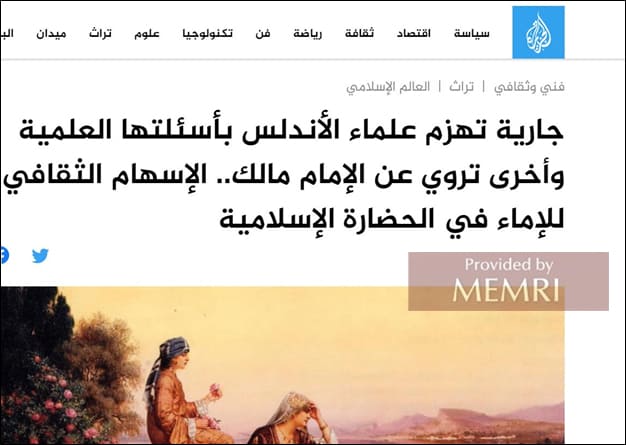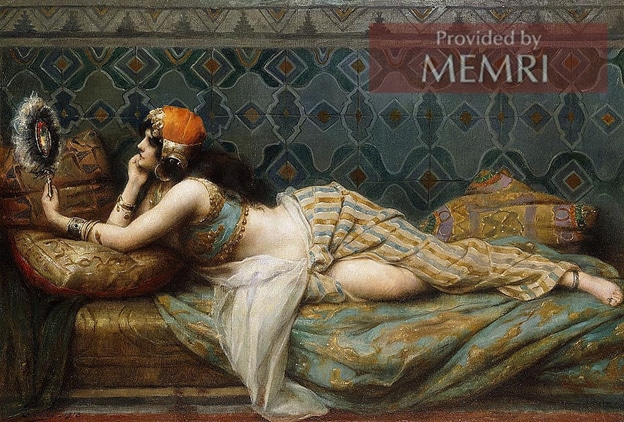
We live in a moment when slavery is much talked about. Driven by progressive activism and movements against police brutality in the West, the issue is much discussed, and is the subject of deep study by elite media and of cruder direct action by street activists. Statues and memorials of such consequential figures as Columbus, Washington, Jefferson and even Lincoln, the Great Emancipator, have been targeted. Calls to radically redesign education, economics and society to address the curse of slavery have followed.
Western media have sternly lectured us about the historical horrors of enslaving other people, erasing their past, and imprinting them with your imperial or colonial mark, and about the toxic legacy of this past, But this garment-rending masochism seems to be a Western thing. In the Middle East, there are still statues honoring slave masters and mass slavers.[1] But beyond physical memorials, slavery as an institution can still be defended in print, with zero accountability or reprimand. Why this is the case is an interesting question worth pondering.
On September 1, the online Arabic website of Al-Jazeera, the Qatari-funded media empire which is one of the biggest and most influential media outlets in the world, featured a fascinating defense of slavery, particularly of the role of slave girls in Islamic civilization, written by Muhammad Shaaban Ayyub.[2] The lengthy piece, approachable but with scholarly pretensions, was a feature on the site's Islamic "Heritage" section which also carried pieces on "the European Defeat before the Andalusian Majority," and "Caliphs and Jurists who built Churches and Crusaders who Christianized Mosques."[3] The overall thrust of the section is, not surprisingly given the Islamist orientation of Al-Jazeera, to give a positive and interesting perspective on Islamic civilization and history.
The article's title is a lengthy one: "A Slave Girl Defeats the Scholars of Al-Andalus with her Scientific Questions and Another Expounds on the Narrative of Imam Malik... the Cultural Contribution of Slaves to Islamic Civilization." Drawing on elements from Islamic history, particularly Islamic Spain and the Middle Eastern Abbasid dynasty, the piece begins with an arresting quote, from an 11th century Muslim slave trader from Spain: "[I]n my possession now are four Roman girls who were ignorant yesterday, but today are wise scholars."
Ayyub notes that the life of a slave in the world of Islam is more complex than often portrayed, and much more than the mere concept of a life as a servant or forced labor or of entertaining and pleasure. Among the greatest contributions of female slaves to Islamic civilization were in the fields of poetry recitation and singing.
The piece is about female slaves, even though much of the citing is from Abbasid Iraq; this is not a piece to read about the fascinating episode of the Zanj Rebellion, the ninth-century revolt of African slaves in what is now Southern Iraq. These African peoples had been enslaved in large numbers on the East African coast and brought to Abbasid-ruled Mesopotamia to work in the region's plantation agriculture and in reclaiming marshland for arable use.[4] Nor is the piece about the remarkable phenomenon of slave soldiers in the Muslim world, those fierce warriors who would rise and rule much of the region for centuries, making and unmaking dynasties – with many of these slave soldiers taken as children from Turkic lands or the Caucasus or what is now Ukraine and Southern Russia.[5]
Aside from the "rise of the educated or cultured slave girl," Ayyub expounds on an interesting historical fact: Almost all of the mothers of the Caliphs of the powerful Abbasid dynasty that ruled most of the Muslim world were slaves. In fact, they were slaves of Persian, Turkic, Greek, Berber and of unknown origin. And although he doesn't give her as much detail as she deserves, the most powerful and famous of all these slave girls was actually of Yemeni Muslim origin, Al-Khayzuran, who was kidnapped and sold into slavery and rose to become the favorite concubine and then wife of the Caliph Al-Mahdi, and the mother of two other Caliphs, including the most celebrated of all, Haroun Al-Rashid. But this was an exceptional case.

SUPPORT OUR WORK

The author explains how slave girls were acquired, first during the Islamic conquests, as chattel taken from conquered people and given as spoils to warriors. Later the slave trade and piracy would supply the bodies that had been previously taken by conquest. Ayyub is quick to point out that in the Mediterranean, both Muslims and Christians traded in slaves and acquired them through pirate raids.
Ayyub, relying on the 20th century American historian Will Durant, asserts that the Jews were key to the slave trade between Europe and Asia, and between the lands of the Muslims and Christians. He adds that here Durant only confirms what the 9th century Abbasid geographer Ibn Khordadbeh transcribed. Ayyub also wants to correct the record, that the "Orientalist image" presented in Western art and film of naked slaves being sold is absolutely false, as this was forbidden by Islamic law. Slave markets were strictly controlled with "only buyers and sellers allowed to enter the slave market in Cairo" (presumably the objects of the buying and selling were also allowed into slave markets).
Much of the article is given over to describing the training of these slave girls, who were schooled in all sorts of arts and skills, and how some excelled and become so valuable as to be worth exorbitant sums – a hundred thousand silver dirhams (equal to $125,000) or even a thousand gold dinars (equal to more than a million dollars). The more trained the girl, the higher the potential profit. He quotes the 11th century Andalusian scholar Ibn al-Kattani, who characterized these slave girls according to different categories: those meant to be servants, or child-rearers or singers and entertainers, and the highest category "concubines who had a high degree of knowledge and beauty enough to possess the hearts of princes." Evidently the slave girls of Spain were good, but were totally outclassed by the slave girls of the Islamic East who were much more valuable and in demand.
In contrast to American images of slavery, all these slave girls were of Caucasian origin. The Umayyad Caliph of Cordoba Abdulrahman III, heir of the Prophet, had blue eyes and had to dye his light beard dark. He was the son and grandson of Basque concubines.[6]
The piece makes for fascinating if uncomfortable reading, not only at a time when people in the West talk are talking about slavery but even more so during a time when a powerful movement called the Islamic State or ISIS, with its own "caliph," openly championed the return of slavery, particularly the very type of slavery this piece romanticizes.[7] Indeed, ISIS's justification of enslaving girls was based on a selective reading of Islamic scripture and an appeal to an idealized vision of Islamic history, as well on the group's own apocalyptic vision.[8] Ayyub's larger point, which has been made throughout history by slave owners and apologists, is that these enslaved people were better off under Islam than they would have been if left in their previous state. They were no longer "barbarians" or infidels, but had moved on to a higher plane of existence.
While the author tries to ground his work in primary sources – except for Will Durant – some things are missing. The type of slave girl that Ayyub praises were unusual, so expensive and exquisite because they were indeed intended for the elite, the period's super-rich. These were exceptional products of a horrific selection process steeped in human cruelty. These slave girls are little known other than by their names (chosen by their masters), the skills they were laboriously taught, and the high prices they fetched. The same could have been said of a prized hound or horse or, to be more generous, of a Roman gladiator who gained renown. Ayyub's chronicle of these "fortunate" and accomplished slave girls who so graced Islamic civilization rings hollow with the absence of all those others, faceless and nameless, who must not have made the grade.
It would be easy to chastise Al-Jazeera for poor taste in publishing this highly skewed slice of Islamic heritage. But this worldview is not that uncommon, and there is little appetite in the East for historical revisionism. Some apologists have even defended historical practices like the Devshirme, the "child tax" of Balkan Christian boys forcibly taken from their families to become Ottoman soldiers, or the dhimmi system and jizya tax enforced on non-Muslims for centuries (modern jihadis and Islamists, not just ISIS, have made incipient efforts to revive the latter).[9]
The reality is that the type of guilt-filled comprehensive public rejection of supposed past misdeeds seems to be a mostly Western, and especially an Anglo-Saxon, innovation. Only time will if the angst and remorse of Westerners builds something more lasting than these paeans to the greatness of Islamic civilization.
*Alberto M. Fernandez is Vice President of MEMRI.
[1] Providencemag.com/2020/07/statues-slavers-imperialists-still-stand-middle-east-turkey-egypt, July 7, 2020.
[2] Aljazeera.net/turath/2020/9/1/%D9%81%D9%82%D9%8A%D9%87%D8%A7%D8%AA-%D8%B7%D8%A8%D9%8A%D8%A8%D8%A7%D8%AA-%D9%85%D9%88%D8%B3%D9%8A%D9%82%D9%8A%D8%A7%D8%AA-%D9%85%D9%87%D9%86%D8%AF%D8%B3%D8%A7%D8%AA, September 1, 2020.
[3] Aljazeera.net/turath.
[4] Medievalists.net/2019/02/zanj-revolt-slave-war-medieval-iraq.
[5] Mamluk.uchicago.edu/MSR_XVI_2012_Yosef_pp55-69.pdf, 2012.
[6] Revistadehistoria.es/las-vasconas-que-engendraron-emires-y-califas-andalusies, November 8, 2017.
[7] Icct.nl/publication/isis-and-their-use-of-slavery, January 27, 2020.
[8] Brookings.edu/blog/markaz/2014/10/14/satans-slaves-why-isis-wants-to-enslave-a-religious-minority-in-iraq, October 14, 2014.
[9] Washingtontimes.com/news/2013/sep/10/egypts-muslim-brotherhood-convert-islam-or-pay-jiz, September 10, 2013.




